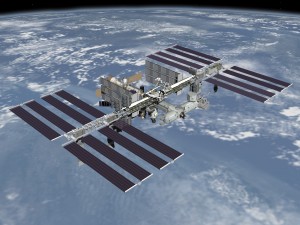NASA is making it easier to spot the International Space Station (ISS) with the naked eye.
The US space agency is offering a new service which alerts people a few hours before the space station is visible flying overhead.
Enthusiasts who sign up the new service, Spot the Station, will receive notifications via email or text message. The program coincides with the Nov. 2 12-year anniversary of ISS crews living and working continuously aboard the orbiting space station.
“It’s really remarkable to see the space station fly overhead and to realize humans built an orbital complex that can be spotted from Earth by almost anyone looking up at just the right moment,” says NASA’s William Gerstenmaier. “We’re accomplishing science on the space station that is helping to improve life on Earth and paving the way for future exploration of deep space.”

The Expedition 1 crew, the first humans aboard the International Space Station in November 2000, enjoy a snack. From left, cosmonaut Yuri P. Gidzenko, Soyuz commander; astronaut William M. Shepherd, mission commander; and cosmonaut Sergei K. Krikalev, flight engineer. (NASA)
The ISS, which flies about 322 km above us, is usually best glimpsed either at dawn or dusk. Next to the moon, it is the brightest object in the night sky. On a clear night, NASA says the space station can be seen as a point of light traveling at about the speed of a fast-moving airplane.
The space station’s size and brightness are about the same as the planet Venus.
Most of the world’s population should be able to see the ISS since it passes over more than 90 percent of people living on Earth.
People who sign up for ”Spot the Station” will be able set their alerts for morning or evening sightings, or both. Also, the new service won’t waste your time or eat up text message units by sending useless information. NASA says it will send notification messages for good sightings only, which is when the ISS passes high enough in the sky to be easily seen over objects like trees and buildings.
NASA’s Johnson Space Center in Houston, Texas, calculates and updates ISS sighting information twice a week for more 4,600 cities and towns throughout the world. The space agency suggests people choose the location nearest to them if they can’t find their specific position on the list.
President Ronald Reagan, during his 1984 State of the Union address, committed the United States to developing a permanently-occupied space station that would not only involve NASA. Other countries were invited to participate as well.
After years of planning and negotiation, the ISS has become a truly international venture. Sixteen nations participate in what NASA calls the most technically and politically complex space exploration program ever undertaken.
The unique partnership includes the space agencies of the United States, Russia, Europe, Japan and Canada, as well as nations that are a part of the European Space Agency: France, Germany, Italy, Denmark, Sweden, Belgium, Netherlands, Spain, United Kingdom, Switzerland, and Norway.
The first portion of what would become the massive International Space Station was launched from the Baikonur Cosmodrome, Kazakstan, on Nov. 20, 1998. Called the Zarya, or “Sunrise,” this ISS module was designed to provide the station’s initial propulsion and power. The space station has a mass of about 450,000 kg, is 72.8 m in length, by 108.5 m in width and is about 20 m in height.
The first humans, a three-person crew known as Expedition 1, boarded the space station on Nov. 2, 2000. The ISS has been continuously staffed with international crews since, hosting 207 people who lived on the space station from a period of weeks to months.
Currently, the lone way crews can be transported to and from the ISS is aboard Russian Soyuz spacecraft. The US is turning to the private sector to help with crew transport after retiring the space shuttle fleet in 2011. NASA
NASA time-lapse animation of the assembly of the International Space Station



 Science World is VOA’s on-air and online magazine covering science, health, technology and the environment.
Science World is VOA’s on-air and online magazine covering science, health, technology and the environment.
13 Responses to “NASA Makes it Easier to Spot Space Station”
When will the space station be over Liverpool England for viewing
Already getting them on twitter for a while now. But thanks for the heads up.
I’ve had the pleasure of spotting the ISS on a couple of occasions, but it’s been a while. This service should get me out into the backyard again!
[...] the rest here: NASA Makes it Easier to Spot Space Station – Voice of America (blog) :america-, and-more-, international, naked, new-service, sci/tech, space, space-station, [...]
i want to see the iss by naked eye .
I salute the courage of those who contributed to this tangible wonder
Something seemed to me as a troyan satellite about to Moon, 60 degrees, few times…
Maybe I am wrong?
Here is a link……http://spotthestation.nasa.gov/
[...] Obama? Election Result May Not Affect NASA MuchSpace.comSydney Morning Herald -The Verge -Voice of America (blog)all 166 news [...]
I am very much exited to know that NASA is making it easier to view SPACE STATION. When will we Kathmanduits (NEPAL) be able to view it on our sky ?
Just seen the ISS shoot across the night sky in Denbigh, North Wales ( United Kingdom ) – 5.05pm on Sunday 23rd December 2012 – and it was a mighty impressive sight. It appeared in exactly the same spot as specified by NASA and it was clearly visible for around 4 minutes.
It still seems a wee bit strange to think it was only 200 miles up there above our heads and i hope they waved back !!!!!
Cheers,
A n d r e w O ‘ T o o l e
happy-new-year–2013–
[...] (source) [...]